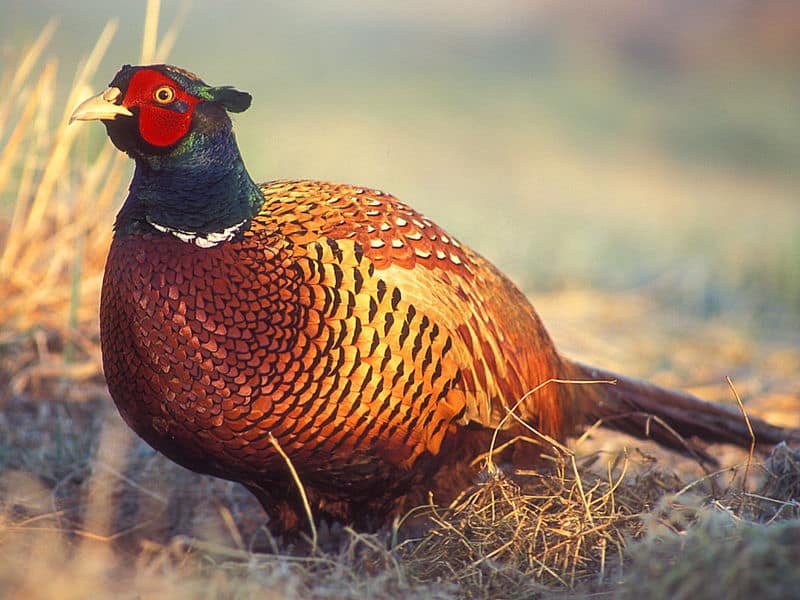There are many different bird genera that belong to the family Phasianidae, which is classified as a suborder of the order Galliformes. [C]onsidered to be a component of the order Galliformes. Pheasants as a genus are only native to Eurasia. Although, they have been widely imported to other regions across the world in recent decades. There are close to 49 different species of pheasants. They can be found in nearly every part of the world. Pheasants may be found in almost every region of the world.
The common pheasant is one of the game birds that is one of the most well-known. Among those that have importance on a global scale, the common pheasant is without a doubt the most ubiquitous and ancient of them all. It is one of the game birds that is sought after the most. It has been purposely brought to a number of different places for the sole goal of acting as a hunting target.
The male common pheasant is known for having very colorful plumage, which has helped to contribute to the bird’s worldwide popularity. In sections of its range where none of its natural cousins are present, such as in Europe, where it has been naturalized and is now known as a native bird species, it is simply referred to as the “pheasant.”
Are you interested in learning about the current population of pheasants across the globe? Continue reading to discover the answer!
What is the Global Population of Pheasants?

The common pheasant may be the most ubiquitous and ancient game bird in the world.
©Lukasz Lukasik / CC BY-SA 3.0, from Wikimedia Commons, the free media repository – License
The number of adult common pheasants in the globe is estimated to range anywhere from 160,000,000 to 219,999,999, according to the IUCN Red List. Europe is home to between 8,290,000,000 and 10,700,000,000 adults, which breaks down to between 4,140,000 and 5,370,000 couples. This species is considered to be of “Least Concern” (LC) by the IUCN Red List at the present time. However, its population is decreasing in some locations.
Where Can One Typically Spot a Pheasant?
The common pheasant, also known as the ring-necked pheasant, is a bird that was first discovered in China and East Asia. It has since been successfully introduced to various parts of the world, including North America. The males of this species exhibit vivid colors and remarkable looks. The colors include blue-green heads, red cheek wattles, and white neck rings. These characteristics give them a stunning appearance. Both males and females have long, pointed tails, however, the ladies are a more muted buff color than the males.
These birds can be found in various habitats, including grassland, shrubland, marsh, and woodland areas. The preferred habitat of common pheasants is grassy areas with a smattering of trees close to water.
Although it originated in Asia, the pheasant has become a popular game bird all around the world. The fact that pheasants are so prevalent in South Dakota has led to the state’s reputation as the “Pheasant Capital of America.” As is the case in a good number of other states, pheasant hunting is legal in this one.
Dangers to the Pheasant Population

Common pheasants are the least-concern species due to their global spread.
©gary noon, CC BY-SA 2.0, via Wikimedia Commons – License
The global distribution of common pheasants is so extensive that the species has been given the least-concern rating. Some local populations of these birds, however, are on the decline. This is due to factors including habitat loss and unchecked illegal hunting. The capacity of the land to maintain wild pheasant populations is decreasing as crop variety is lost and the use of pesticides is increasing in the vicinity of agricultural zones that are visited by pheasants.
Because of their shrewdness and ability to evade capture in the wild, game hunters often covet these beautiful birds more than any other in the world. It would appear that this has contributed to a decrease in the pheasant population in locations that are popular for shooting. However, thanks to management and reintroduction efforts, many populations have exhibited signs of growth in spite of annual harvests in the thousands.
Are Pheasants Good for the Environment?
The common pheasant eats a diverse range of plant and fruit species. As a result, they help control insect populations while also dispersing the seeds of the plants and fruits they consume. Their food consists of various plant and animal components. This includes berries, fruit, grain, leaves, mast, and seeds.
They also consume a wide variety of other things, including:
- Ant Eggs
- Caterpillars
- Field Mice
- Grasshoppers
- Leatherjackets
- Lizards
- Small Animals
- Smaller Birds
- Wireworms
These birds are an important source of food for many local predators, including snapping turtles, badgers, birds of prey, coyotes, foxes, and raccoons, to name just a few. As a consequence of this, they constitute an essential component of the ecological food chain.
The photo featured at the top of this post is © Common_Pheasant_Phasianus_Colchicus.jpg: David Croad derivative work: Donkey shot, CC BY 3.0, via Wikimedia Commons – License / Original
Thank you for reading! Have some feedback for us? Contact the AZ Animals editorial team.






